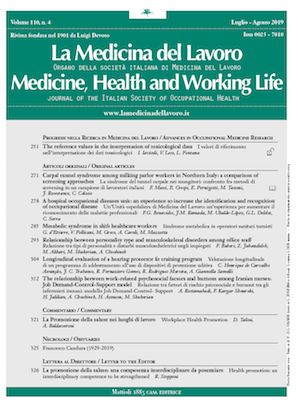Carpal tunnel syndrome among milking parlor workers in Northern Italy: a comparison of screening approaches
Main Article Content
Keywords
wrist, biomechanical over load, carpal tunnel syndrome
Abstract
Background: Occupational tasks characterized by repetitive, awkward and forceful movements of the hand and wrist may heighten the risk of carpal tunnel syndrome (CTS) among dairy parlor workers. Median nerve impairment can be investigated with ultrasonography (US) and nerve conduction studies (NCS) but a structured questionnaire may help identify early symptoms. Objectives: Our objectives were to: a) compare the sensitivity of US investigations and NCS to detect early signs of CTS; b) explore the correlation of the results of these two tests with CTS symptoms obtained from the administration of a targeted questionnaire. Methods: Forty male milking parlor workers were recruited. The study protocol included: 1) the identification of characteristic CTS symptoms through a targeted questionnaire; 2) US imaging of the carpal tunnel inlet (using a portable ultrasound device; 3) NCS of the distal median nerve. Results: The symptom questionnaire was considered positive if at least one CTS symptom was present within two weeks prior to the examination. The symptom questionnaire showed a high level of specificity (92,6%) and sensitivity (61%) when compared with NCS results. Ultrasound results revealed a prevalence of median neuropathy of 55%, but when compared to NCS, the ultrasound showed quite low predictive values (NPV of 37% and PPV of 38%). Discussion: The symptom questionnaire was associated with the median nerve pathology often seen in CTS. Moreover, the study results have shown the questionnaire to be the most effective screening method when compared to ultrasound.






